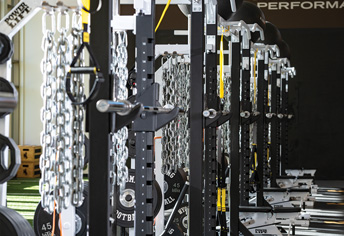
Contact Us
Institutional Communications
Bureau of Mines Building, Room 137
Laramie, WY 82071
Phone: (307) 766-2929
Email: cbaldwin@uwyo.edu
High-Tech Athletes
January 8, 2021

UW Athletics employs the latest technology to maximize performance and avoid injury.
By Micaela Myers
In the age of technology, it’s not surprising that University of Wyoming Athletics employs the latest tools to improve performance and athlete health, including altitude simulation chambers and GPS monitoring.
Step Inside the Simulation Chamber
As athletics officials designed the new High Altitude Performance Center, they wanted to incorporate technology few schools can offer: altitude simulation chambers to increase oxygen in the bloodstream.
“Our original thought with those rooms was to help with concussion recovery,” says Director of Sports Medicine Scott Knerr. “Once we got the room in athletic training set up, it turned into just a general recovery room that our athletes enjoy using.”
At high altitudes such as Laramie’s, there’s a lower concentration of oxygen in the air. The chambers have a higher concentration of pressure, which increases oxygen levels.
“Anytime you’re increasing oxygen in blood, you’re going to have healing,” Knerr says.
The vinyl walls allow the athletes to see out, while the pressure system provides soothing white noise.
“We have athletes who will sit in the lounge chairs there and study in between classes,” Knerr says. “We also have some pressurized boots in there that help with recovery for the legs. It’s been a great tool for us. The athletes really see a benefit from it.”
For maximum benefits, athletes spend at least 20-30 minutes in the chamber, and the room can accommodate approximately five athletes at a time. Athletes from 17 different sports use the room.
A second room is located in the strength and conditioning center to allow student-athletes to simulate training at different altitudes.
“The nice thing about these rooms is that we’re not pumping in oxygen, we’re just increasing the pressure,” Knerr says. “We leave them set at the equivalent of 1,500 feet above sea level. If you have higher pressure in the room, you’re going to increase the transmission of oxygen from the air into the lungs and bloodstream.”
GPS Maximizes Potential
Cowboy football uses Polar Team Pro GPS systems to prepare athletes prior to the season and to ensure their training is on target during the season. The 45 units provide internal and external data—from movement like the GPS mapping on your phone to acceleration and heart rate.
“The main variable that the GPS measures is the yardage—how far these guys run and how fast they run,” says football’s Director of Sports Performance Eric Donoval. “It measures high-intensity accelerations and decelerations. That’s essentially how explosive the athlete is. It gives us the internal load that the heart works. So it gives us a lot of different variables through our system.”
The small unit is worn around the athlete’s torso during practice, workouts and games.
“By accumulating that data, it allows us to really hone our training to make sure that we expose these guys, from a position standpoint, to the demands they’re going to face in camp and in practice,” Donoval says.
Data is also used to make sure players aren’t over or under training for game day. Donoval began using the tech at Louisiana State University and made the investment when he joined the team at UW in 2018.
“Injury happens when there’s a high spike in intensity or volume,” he says. “If we can prepare these guys through the off season for the rigors of practice and games, they have a much higher likelihood of not getting injured.”
Contact Us
Institutional Communications
Bureau of Mines Building, Room 137
Laramie, WY 82071
Phone: (307) 766-2929
Email: cbaldwin@uwyo.edu


